Abstract
Tyrosinase-positive oculocutaneous albinism (ty-pos OCA) is an autosomal recessive disorder of the melanin pigmentary system. South African ty-pos OCA individuals occur with two distinct phenotypes, with or without darkly pigmented patches (ephelides, or dendritic freckles) on exposed areas of the skin. These phenotypes are concordant within families, suggesting that there may be more than one mutation at the ty-pos OCA locus. Linkage studies carried out in 41 families have shown linkage between markers in the Prader-Willi/Angelman syndrome (PWS/AS) region on chromosome 15q11-q13 and ty-pos OCA. Analysis showed no obligatory crossovers between the alleles at the D15S12 locus and ty-pos OCA, suggesting that the D15S12 locus is very close to or part of the disease locus, which is postulated to be the human homologue, P, of the mouse pink-eyed dilution gene, p. Unlike caucasoid "ty-pos OCA" individuals, negroid ty-pos OCA individuals do not show any evidence of locus heterogeneity. Studies of allelic association between the polymorphic alleles detected at the D15S12 locus and ephelus status suggest that there was a single major mutation giving rise to ty-pos OCA without ephelides. There may, however, be two major mutations causing ty-pos OCA with ephelides, one associated with D15S12 allele 1 and the other associated with D15S12 allele 2. The two loci, GABRA5 and D15S24, flanking D15S12, are both hypervariable, and many different haplotypes were observed with the alleles at the three loci on both ty-pos OCA-associated chromosomes and "normal" chromosomes.(ABSTRACT TRUNCATED AT 250 WORDS)
Full text
PDF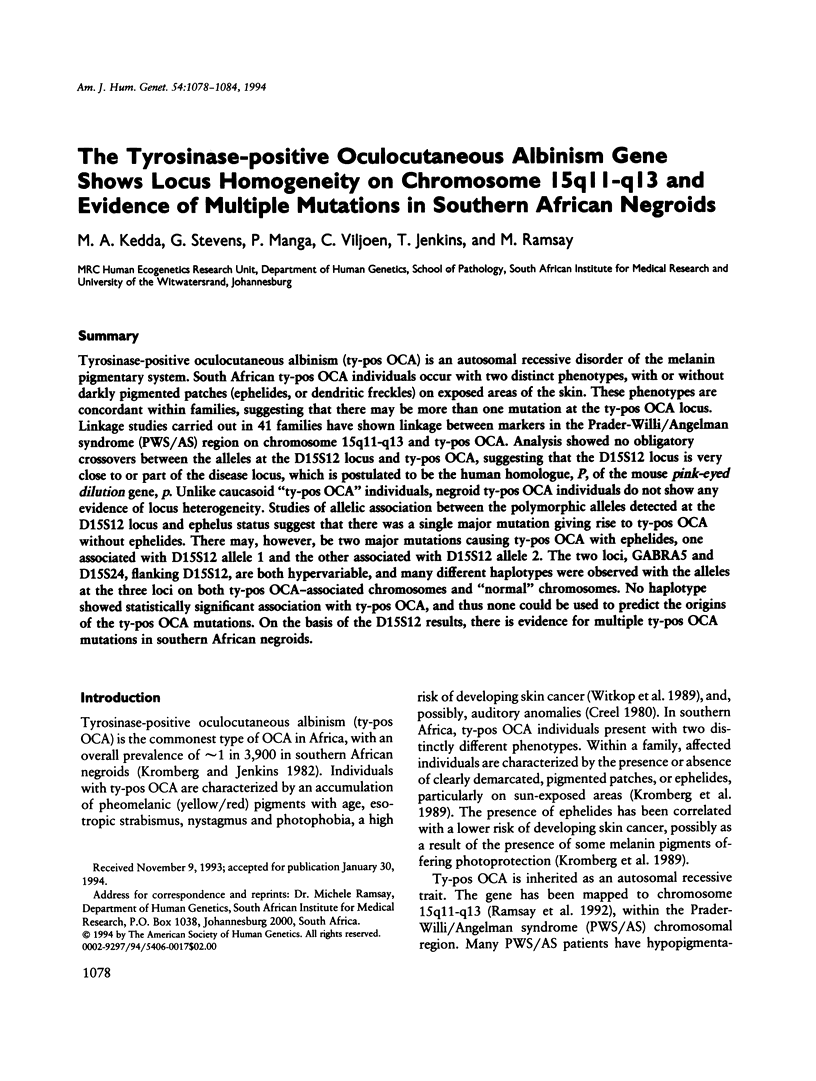
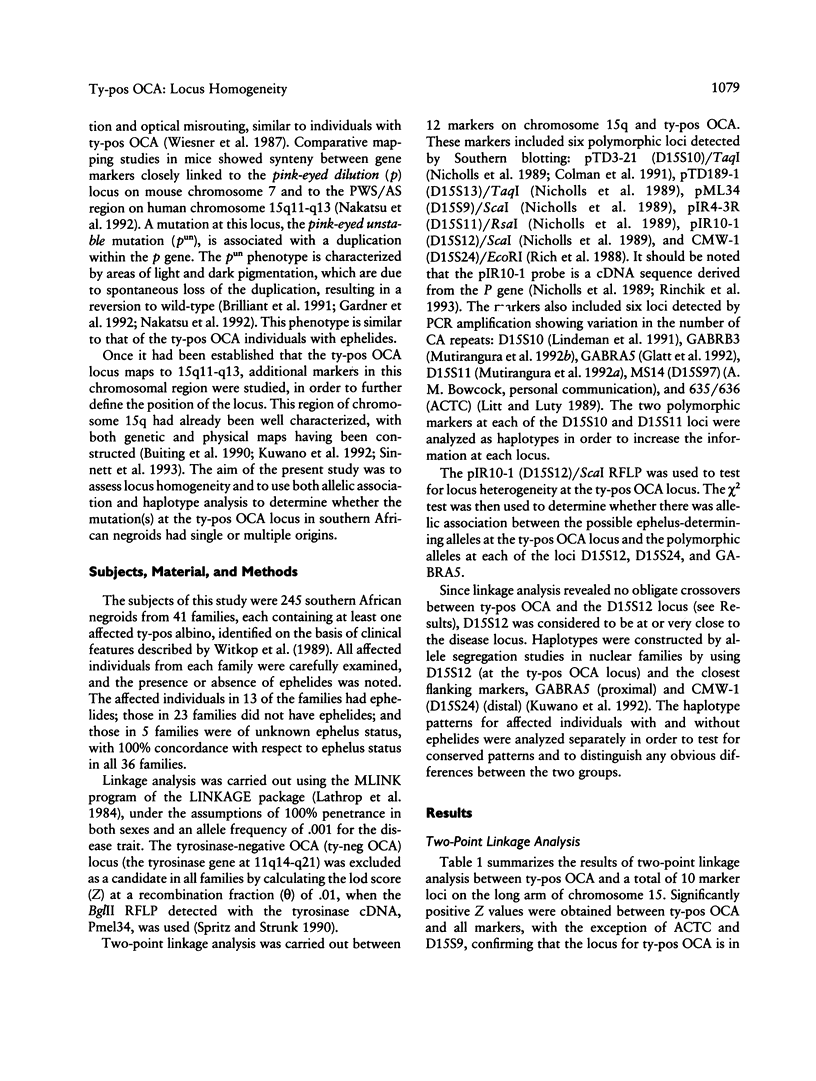
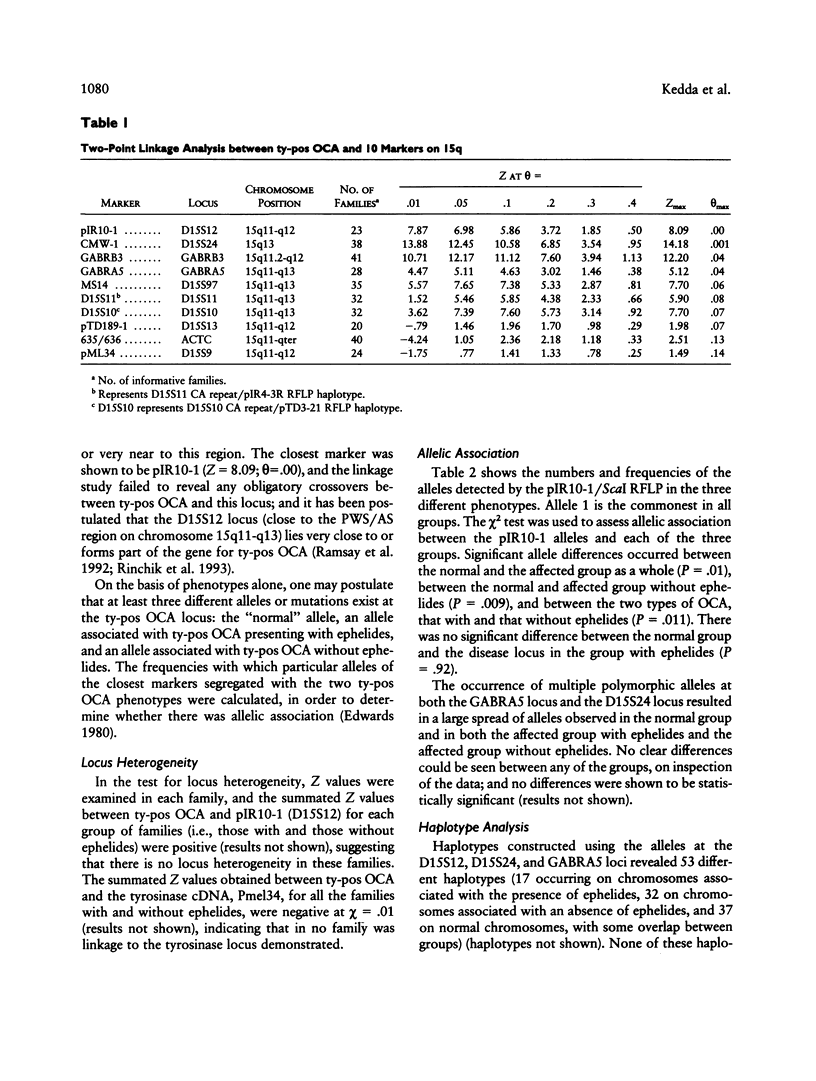
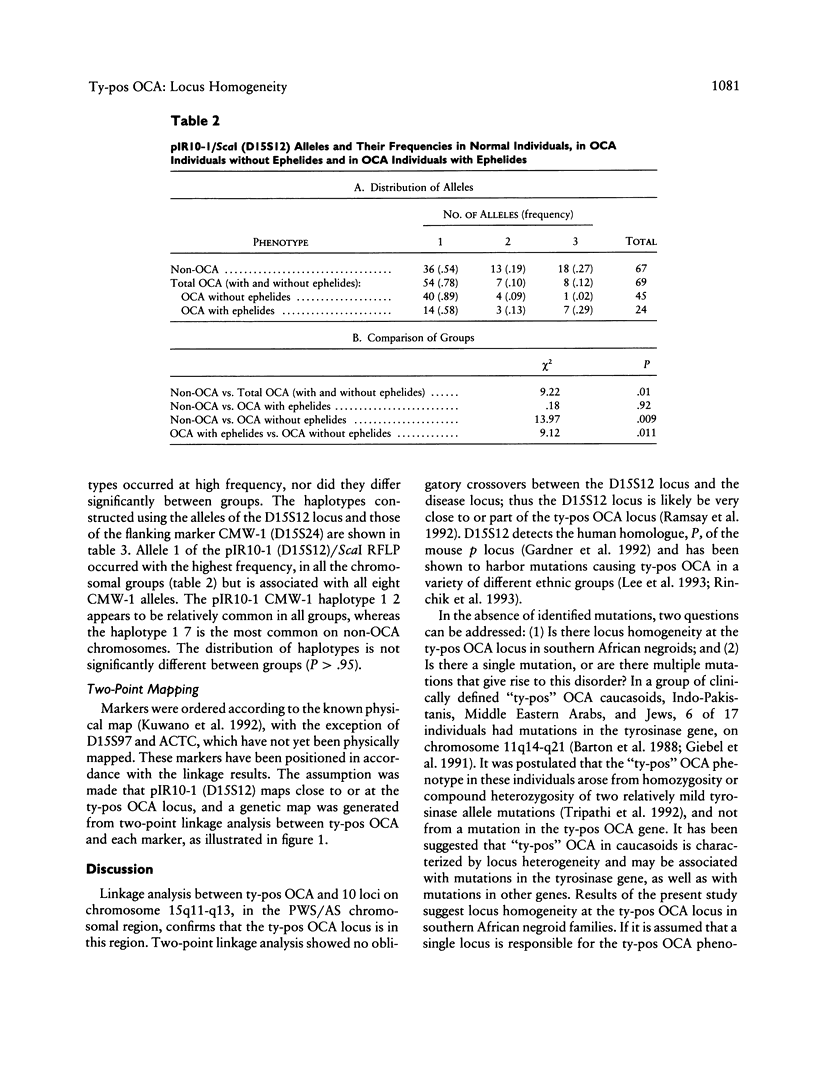
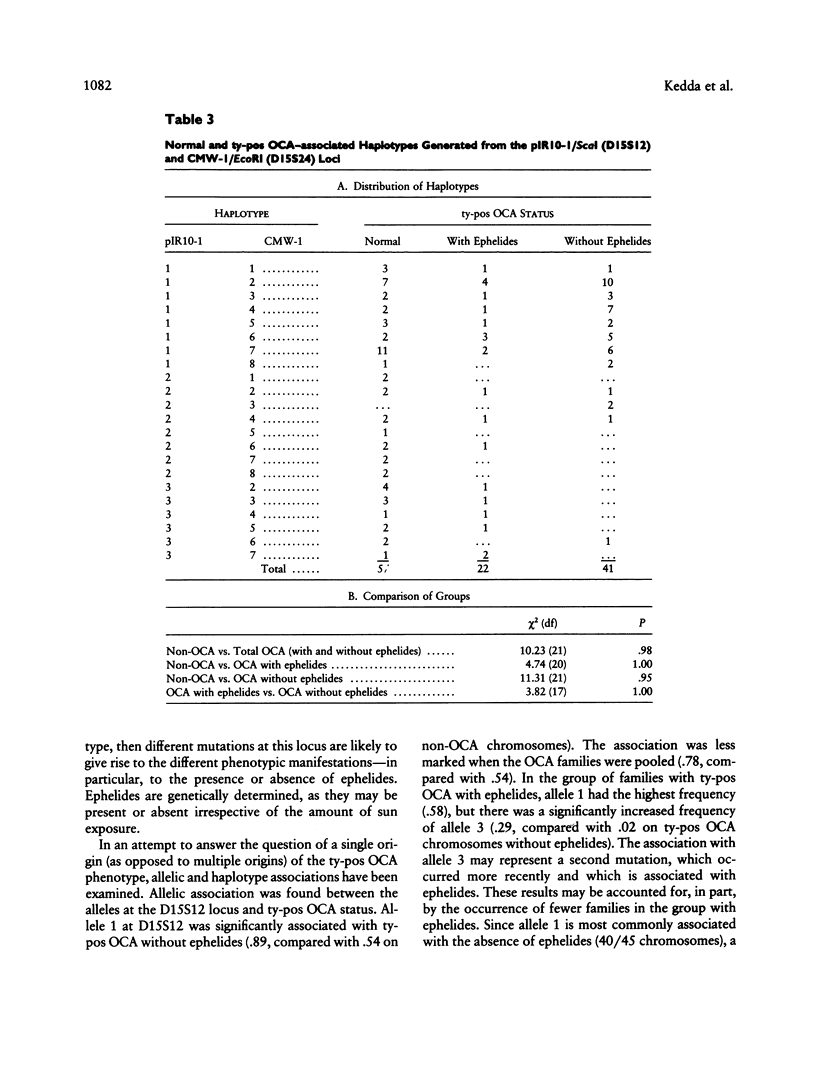
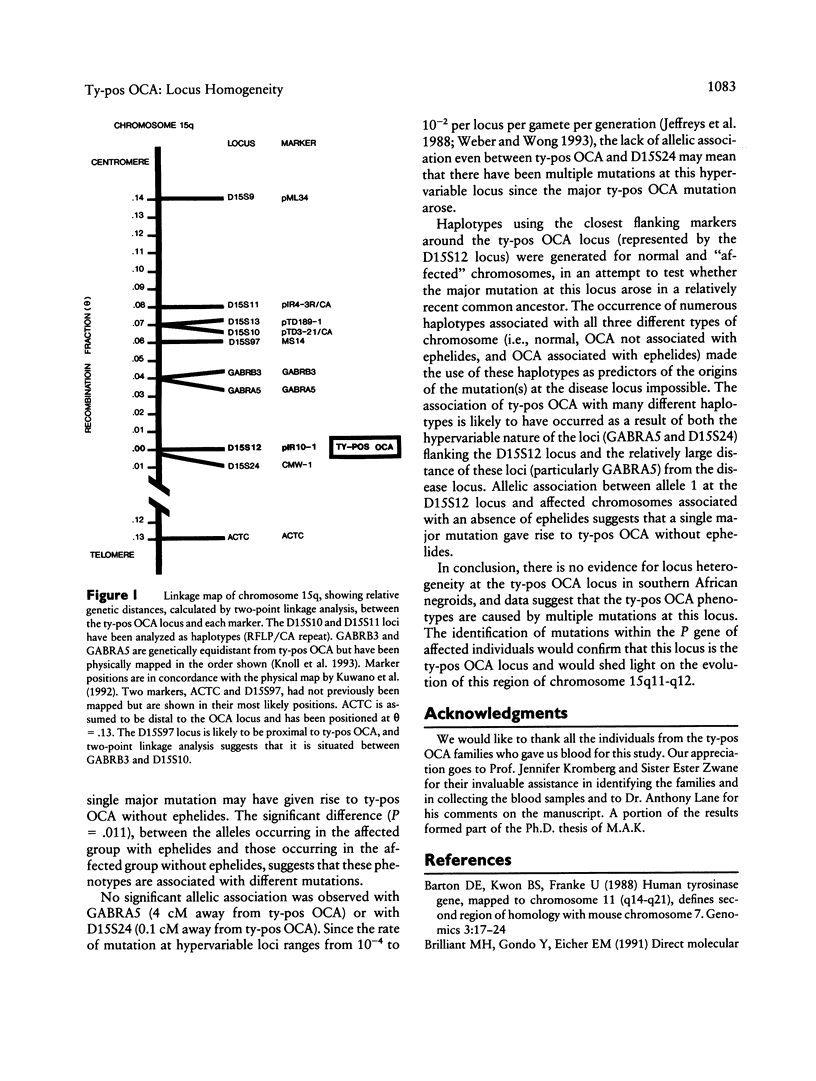
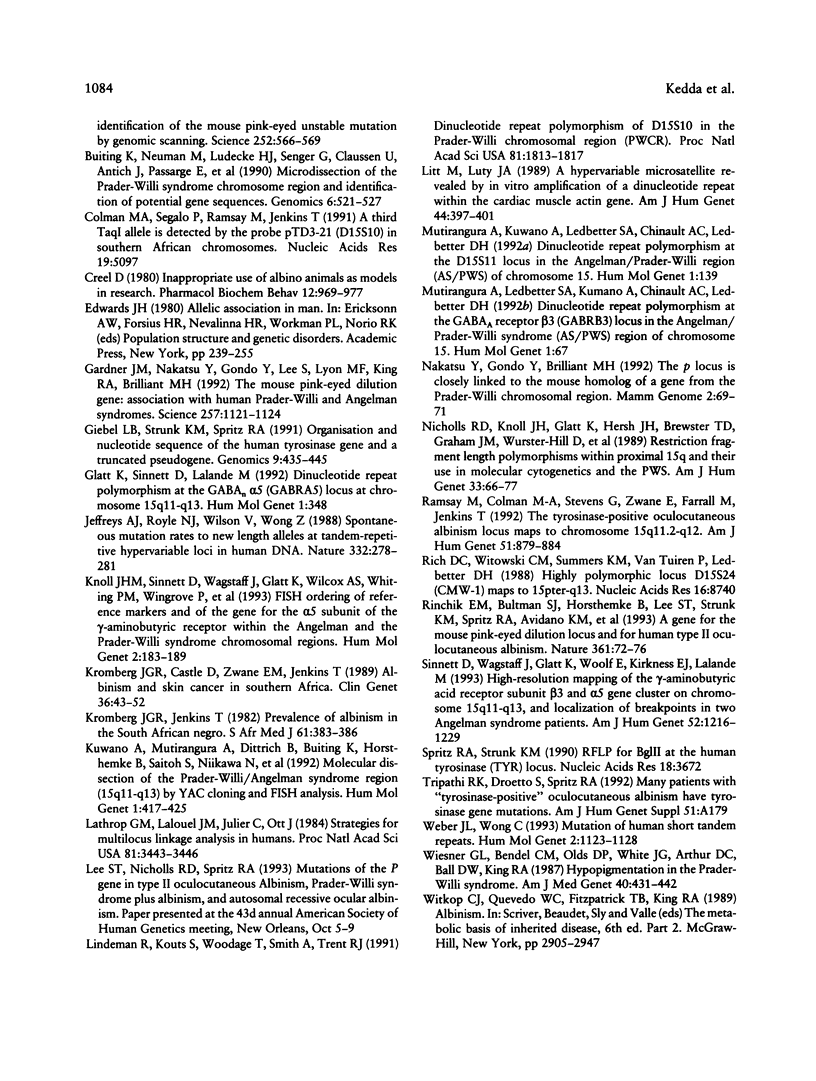
Selected References
These references are in PubMed. This may not be the complete list of references from this article.
- Barton D. E., Kwon B. S., Francke U. Human tyrosinase gene, mapped to chromosome 11 (q14----q21), defines second region of homology with mouse chromosome 7. Genomics. 1988 Jul;3(1):17–24. doi: 10.1016/0888-7543(88)90153-x. [DOI] [PubMed] [Google Scholar]
- Brilliant M. H., Gondo Y., Eicher E. M. Direct molecular identification of the mouse pink-eyed unstable mutation by genome scanning. Science. 1991 Apr 26;252(5005):566–569. doi: 10.1126/science.1673574. [DOI] [PubMed] [Google Scholar]
- Buiting K., Neumann M., Lüdecke H. J., Senger G., Claussen U., Antich J., Passarge E., Horsthemke B. Microdissection of the Prader-Willi syndrome chromosome region and identification of potential gene sequences. Genomics. 1990 Mar;6(3):521–527. doi: 10.1016/0888-7543(90)90481-9. [DOI] [PubMed] [Google Scholar]
- Colman M. A., Segalo P., Ramsay M., Jenkins T. A third TaqI allele is detected by the probe pTD3-21 (D15S10) in southern African chromosomes. Nucleic Acids Res. 1991 Sep 25;19(18):5097–5097. doi: 10.1093/nar/19.18.5097. [DOI] [PMC free article] [PubMed] [Google Scholar]
- Creel D. Inappropriate use of albino animals as models in research. Pharmacol Biochem Behav. 1980 Jun;12(6):969–967. doi: 10.1016/0091-3057(80)90461-x. [DOI] [PubMed] [Google Scholar]
- Gardner J. M., Nakatsu Y., Gondo Y., Lee S., Lyon M. F., King R. A., Brilliant M. H. The mouse pink-eyed dilution gene: association with human Prader-Willi and Angelman syndromes. Science. 1992 Aug 21;257(5073):1121–1124. doi: 10.1126/science.257.5073.1121. [DOI] [PubMed] [Google Scholar]
- Giebel L. B., Strunk K. M., Spritz R. A. Organization and nucleotide sequences of the human tyrosinase gene and a truncated tyrosinase-related segment. Genomics. 1991 Mar;9(3):435–445. doi: 10.1016/0888-7543(91)90409-8. [DOI] [PubMed] [Google Scholar]
- Glatt K. A., Sinnett D., Lalande M. Dinucleotide repeat polymorphism at the GABAA receptor alpha 5 (GABRA5) locus at chromosome 15q11-q13. Hum Mol Genet. 1992 Aug;1(5):348–348. doi: 10.1093/hmg/1.5.348. [DOI] [PubMed] [Google Scholar]
- Jeffreys A. J., Royle N. J., Wilson V., Wong Z. Spontaneous mutation rates to new length alleles at tandem-repetitive hypervariable loci in human DNA. Nature. 1988 Mar 17;332(6161):278–281. doi: 10.1038/332278a0. [DOI] [PubMed] [Google Scholar]
- Knoll J. H., Sinnett D., Wagstaff J., Glatt K., Wilcox A. S., Whiting P. M., Wingrove P., Sikela J. M., Lalande M. FISH ordering of reference markers and of the gene for the alpha 5 subunit of the gamma-aminobutyric acid receptor (GABRA5) within the Angelman and Prader-Willi syndrome chromosomal regions. Hum Mol Genet. 1993 Feb;2(2):183–189. doi: 10.1093/hmg/2.2.183. [DOI] [PubMed] [Google Scholar]
- Kromberg J. G., Castle D., Zwane E. M., Jenkins T. Albinism and skin cancer in Southern Africa. Clin Genet. 1989 Jul;36(1):43–52. doi: 10.1111/j.1399-0004.1989.tb03365.x. [DOI] [PubMed] [Google Scholar]
- Kromberg J. G., Jenkins T. Prevalence of albinism in the South African negro. S Afr Med J. 1982 Mar 13;61(11):383–386. [PubMed] [Google Scholar]
- Kuwano A., Mutirangura A., Dittrich B., Buiting K., Horsthemke B., Saitoh S., Niikawa N., Ledbetter S. A., Greenberg F., Chinault A. C. Molecular dissection of the Prader-Willi/Angelman syndrome region (15q11-13) by YAC cloning and FISH analysis. Hum Mol Genet. 1992 Sep;1(6):417–425. doi: 10.1093/hmg/1.6.417. [DOI] [PubMed] [Google Scholar]
- Lathrop G. M., Lalouel J. M., Julier C., Ott J. Strategies for multilocus linkage analysis in humans. Proc Natl Acad Sci U S A. 1984 Jun;81(11):3443–3446. doi: 10.1073/pnas.81.11.3443. [DOI] [PMC free article] [PubMed] [Google Scholar]
- Litt M., Luty J. A. A hypervariable microsatellite revealed by in vitro amplification of a dinucleotide repeat within the cardiac muscle actin gene. Am J Hum Genet. 1989 Mar;44(3):397–401. [PMC free article] [PubMed] [Google Scholar]
- Mutirangura A., Kuwano A., Ledbetter S. A., Chinault A. C., Ledbetter D. H. Dinucleotide repeat polymorphism at the D15S11 locus in the Angelman/Prader-Willi region (AS/PWS) of chromosome 15. Hum Mol Genet. 1992 May;1(2):139–139. doi: 10.1093/hmg/1.2.139-a. [DOI] [PubMed] [Google Scholar]
- Mutirangura A., Ledbetter S. A., Kuwano A., Chinault A. C., Ledbetter D. H. Dinucleotide repeat polymorphism at the GABAA receptor beta 3 (GABRB3) locus in the Angelman/Prader-Willi region (AS/PWS) of chromosome 15. Hum Mol Genet. 1992 Apr;1(1):67–67. doi: 10.1093/hmg/1.1.67. [DOI] [PubMed] [Google Scholar]
- Nakatsu Y., Gondo Y., Brilliant M. H. The p locus is closely linked to the mouse homolog of a gene from the Prader-Willi chromosomal region. Mamm Genome. 1992;2(1):69–71. doi: 10.1007/BF00570442. [DOI] [PubMed] [Google Scholar]
- Nicholls R. D., Knoll J. H., Glatt K., Hersh J. H., Brewster T. D., Graham J. M., Jr, Wurster-Hill D., Wharton R., Latt S. A. Restriction fragment length polymorphisms within proximal 15q and their use in molecular cytogenetics and the Prader-Willi syndrome. Am J Med Genet. 1989 May;33(1):66–77. doi: 10.1002/ajmg.1320330109. [DOI] [PubMed] [Google Scholar]
- Ramsay M., Colman M. A., Stevens G., Zwane E., Kromberg J., Farrall M., Jenkins T. The tyrosinase-positive oculocutaneous albinism locus maps to chromosome 15q11.2-q12. Am J Hum Genet. 1992 Oct;51(4):879–884. [PMC free article] [PubMed] [Google Scholar]
- Rich D. C., Witkowski C. M., Summers K. M., van Tuinen P., Ledbetter D. H. Highly polymorphic locus D15S24 (CMW-1) maps to 15pter-q13. [HGM9 provisional no. D15S24]. Nucleic Acids Res. 1988 Sep 12;16(17):8740–8740. doi: 10.1093/nar/16.17.8740. [DOI] [PMC free article] [PubMed] [Google Scholar]
- Rinchik E. M., Bultman S. J., Horsthemke B., Lee S. T., Strunk K. M., Spritz R. A., Avidano K. M., Jong M. T., Nicholls R. D. A gene for the mouse pink-eyed dilution locus and for human type II oculocutaneous albinism. Nature. 1993 Jan 7;361(6407):72–76. doi: 10.1038/361072a0. [DOI] [PubMed] [Google Scholar]
- Sinnett D., Wagstaff J., Glatt K., Woolf E., Kirkness E. J., Lalande M. High-resolution mapping of the gamma-aminobutyric acid receptor subunit beta 3 and alpha 5 gene cluster on chromosome 15q11-q13, and localization of breakpoints in two Angelman syndrome patients. Am J Hum Genet. 1993 Jun;52(6):1216–1229. [PMC free article] [PubMed] [Google Scholar]
- Spritz R. A., Strunk K. M. RFLP for BgIII at the human tyrosinase (TYR) locus. Nucleic Acids Res. 1990 Jun 25;18(12):3672–3672. doi: 10.1093/nar/18.12.3672-a. [DOI] [PMC free article] [PubMed] [Google Scholar]
- Weber J. L., Wong C. Mutation of human short tandem repeats. Hum Mol Genet. 1993 Aug;2(8):1123–1128. doi: 10.1093/hmg/2.8.1123. [DOI] [PubMed] [Google Scholar]
- Wiesner G. L., Bendel C. M., Olds D. P., White J. G., Arthur D. C., Ball D. W., King R. A. Hypopigmentation in the Prader-Willi syndrome. Am J Hum Genet. 1987 May;40(5):431–442. [PMC free article] [PubMed] [Google Scholar]


